Vakrasana: Health Benefits, Steps,Types & Variation
What is Vakrasana/Half Spinal Twist Posture?
Vakrasana is a clarified form of Ardhamatsyendrasana. The Sanskrit name of both the poses differs whereas the English name remains the same. In some places, the Ardhamatsyendrasana is known as half spinal twist posture and Vakrasana is simply called twist posture in English.
As said earlier Vakrasana is a clarified form of Ardhamatsyendrasana. For many people who cannot do Ardhamatsyendrasana, Vakrasana is prescribed for them. Through the practice of Vakrasana, gradually Ardhamatsyendrasana pose can be achieved.
It is very helpful to tone spinal nerves and abdominal organs and muscles. It is also advantageous to manage or cure many diseases and disorders.
Vakra refers to twisted and asana indicates a yoga pose. It means it’s a yoga pose where appropriate twisting is experienced. Twisting is noticed in the spinal region, that is why it is also famous as the half spinal twist pose or easy spinal twist pose. Though, Vakrasana seems to be a simple yoga pose yet it gives adequate twisting and stretching to the lower abdomen thus quite effective for the health of body organs viz. pancreas, liver, stomach, kidney, ovary, testis, and intestine. The practice of the pose is a boon in the case of diabetes. the daily practice also helps to burn off belly fat. It is also one of the essential yoga poses of the common yoga protocol of the International Day of Yoga.
What are the Health Benefits of Vakrasana?
All the yoga twist poses like Vakrasana have vast benefits if they are practiced correctly and regularly. Some amazing benefits of Vakrasana are:
- Spine and back nerves: Vakrasana benefits the back nerves and spinal nerves. The practice of the twisted pose is known to give excellent compression and extension of the spine and back nerves enhancing the condition of the back, spine, and muscle nerves.
- Lung Purification: The twists and compression from the yoga posture aid the body squeeze out the stagnated and sluggish blood from the spinal region and circulating it to the lungs and heart for purification. This results in improved lung capacity and purification.
- Back Pain: The daily practice of Vakrasana benefits in treating headaches, back pain, and neck pain.
- Flexibility: Vakrasana is one of the best post-yoga poses that decreases the stiffness in the body and increases its flexibility. People with a stiff body should daily practice Vakrasana.
- Prevents old age issues: Vakrasana stops the adjacent vertebrae from fusing which is a common problem in elderly people.
- Slip disc treats: The yoga practice is beneficial in treating mild cases of slipped discs and sciatica.
- Diabetes: Vakrasana is advantageous in cases of Diabetes. The yoga poses give excellent massage to the abdominal organs including the pancreas. Practising the pose activates the pancreas and signals the beta cells of the pancreas to secrete more insulin. Insulin secretion makes sure blood sugar control and thus benefits diabetes. The twisted pose is also useful in treating problems like indigestion, rheumatism, and constipation.
- Weight loss yoga: The yoga pose provides adequate twist and compression in the abdominal region and daily practice of the asana helps to decrease belly fat and love handles.
- Blood Circulation: The stretching and compression in the abdominal organs facilitate re circulation of blood and toning of the associated nerves.
- Stress and Strain relief: Extremely advantageous yoga poses for people experiencing stress or strain in the back due to the practice of forwarding bending asanas.
- Improves digestion: Vakrasana enhances the digestion process as the twists and compression in the abdominal area promote the release of digestive juices.
- Cures headache: The spinal twist yoga pose aids in the circulation of blood to our brain and this aids in getting rid of a headache and refreshes the mind.
- Benefits to the urinary system: Practising Vakrasana makes ensures the proper flow of oxygen, blood, and nutrients to the urinary region and thus encourages a healthy urinary system and prevents UTIs.
What are the Preparatory poses before Vakrasana?
- Vajrasana
- Ustrasana
- Shasakasana
- Stickasana
- Dandasana
- Tadasana
- Shavasana
- Bhadrasana
How to Perform Vakrasana?
Sit down stretching your legs forward on the floor.
Place your hands beside your thighs or buttocks.
Bend your left leg straight and stretch.
Keep the right foot beside the left knee and the right knee raised upward.
Inhale and lift the arms shoulder high, keeping the elbows straight.
Exhaling, twist to the right, place the left arm by the outer side of the right knee and hold the right ankle with the left hand.
Take the right hand behind the back keeping the palms on the ground.
Look backward towards the right side.
Hold on to the pose.
The final pose of each stage should be held while breathing, naturally. stay in the position as long as comfortable.
Then inhale and lift the left arm shoulder high, keeping the elbows extended.
Exhaling, release the right twist, and place the left hand by the side of the left buttock and the right hand by the side of the right buttock.
Take a deep breath and release.
Repeat the same from the opposite side.
Perform on both sides.
How to do vakrasana by watching a video?
What are Beginner’s Tips for Vakrasana?
- If you find it difficult to touch the outside of your right leg with your left arm, then place a blanket or bolster beside your right foot and rest your left arm on it. This will make it safe for you to twist.
- Make sure that while twisting, you keep the spine erect and do not hunch over.
- Do not force yourself into the position if you are unable to perform so. Instead, relax in Sukhasana (Easy Pose) and practice this pose regularly until you become comfortable doing it.
- Once you can perform the pose comfortably, try performing it without support from a blanket or bolster.
Which Points to remember to practice Vakrasana Steps?
- When you are doing Vakrasana yoga try to minimise the movement in the back region. This will aid you in practising Vakrasana in a much better way and assist you to get the optimum Vakrasana benefits. When you do Vakrasana yoga, make sure you do not put an extreme strain on your spine region. Excessive strain on the spine may result in injury. Perform this correctly, and this will help you get Vakrasana advantages, instead of putting a strain on your spine.
- While performing Vakrasana make sure that your shoulders are on the same level.
- While performing Vakrasana yoga your back should be straight.
What is the Variation of the Vakrasana pose?
Chair Seated Twists
Take a sit sideways on the chair, facing to the right. Twist your upper body toward the right, holding onto the back of the chair, for a spinal twist.
Elongate your spine on each inhale and twist on each exhale for five breaths.
Move your legs around to the left side of the chair and repeat the twist to the left side.
What are the Top facts related to Vakrasana?
- Vakrasana may seem extremely hard in the beginning if you have a stiff body as the yoga pose needs flexibility for proper execution.
- The back should be passive while doing twisted yoga to achieve the maximum advantages of Vakrasana.
- The back should be upright and neutral in the final pose.
- Vakrasana is among the finest yoga asana for spine health.
- The yoga pose has amazing advantages for people suffering from diabetes, menstrual disorders, spondylosis, anorexia, constipation, and cervical pain.
- Vakrasana is best for the reproductive system as it raises the blood flow, nutrients flow, and oxygen flows in the pelvic region.
- In the hath yoga, the Vakrasana is allocated at the 9th position out of the 12-yoga posture.
- Vakrasana is among one of the best kids and adults yoga benefiting different organs and curing various health issues.
How to breathe during Vakrasana?
While you are performing the Vakrasana or the spinal twist yoga, the correct method of breathing should be followed. Breathe out slowly while you twist the body. Do not hurry into breathing and try to breathe slowly and peacefully. Try to keep the position in the last step and inhale while returning to the beginning position.
The spine should be straight, and the muscles should be active.
Compress the elbow into the knee.
Plant your big toe.
What are the Types of Vakrasana?
There are certain types of Vakrasana:
- Uttan Vakrasana (Spinal Twisting Pose)
- One Leg Uttana Vakrasana
- Vishishta Uttan Vakrasana Spinal Twist with legs crossed
- Meru Vakrasana
- Gatyatmak Meru Vakrasana(Dynamic Spinal Twist)
Uttan Vakrasana (Spinal Twisting Pose)
Benefits of Uttan Vakrasana:
- Gives the best massage to the lumbar region and the entire spine.
- Gives stimulation to the liver and pancreas.
- Removes undesirable blood around the pancreas, kidneys, liver, and sex glands.
- Increases lung capacity.
- Reduces the tiredness of the upper extremities, particularly of the spine.
- Placing the palms behind your head aids in the case of a frozen shoulder and makes the shoulder joints flexible.
How to do Uttan Vakrasana?
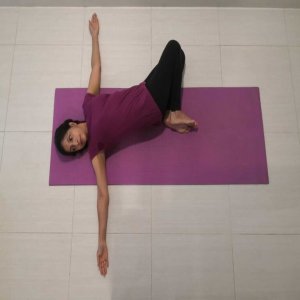
Lie in a supine position; flex both the knees so that your feet rest on the ground; feet are close to your hips; knees are together or a little apart as per your comfort; both the hands are extended sideways in cross position; modify your lower back by pushing your tail bone towards the heels so that there is no arch at the lower back.
Exhale and while exhaling, slowly turn both the knees to the left side and simultaneously turn your head to the right side; both the shoulders are pressing against the ground; maintain the stretch at your upper body and hold the position for 1 minute with regular breathing; now move the flex knees in the middle with inhalation and then place it to the right side with the exhalation; gradually hold the pose for 2-3 minutes with normal breathing.
As an alternative to this, you can also move both hands to the opposite side of the flex knees.
You can also choose to bend your elbows and put both the palms at the back of your head instead of stretching it out.
Contraindications of Uttan Vakrasana:
- Avoid in case of enlarged spleen and liver, any spinal problem, or acute abdominal pain.
One Leg Uttana Vakrasana
What is One Leg Uttana Vakrasana?
One Leg Uttan Vakrasana is a soft lying down twisting pose which works especially on activating your spine.
Benefits of One Leg Uttana Vakrasana:
- Back Pain: Twisting movement aids stretch the entire spine thereby dealing with back pain or any kind of back issue including sciatica, slipped disc, etc. For Runners, hikers, cyclists, and soccer, basketball, and tennis players.
- Hip Opener: Works on stretching your gluteal and hamstrings muscles. You can experience the stretch from the gluteal muscles to the iliotibial band, which is running down the side of the hip.
- Thyroid / Neck Stretch: Turning your neck to one side in this posture aids strengthen neck muscles and at the same time reduces stiffness from the neck. It also aids massage your parathyroid and thyroid gland.
- Frozen /Tight Shoulders: The posture aids release tension from your shoulder and is helpful in case of stiff and frozen shoulders. With daily practice of this posture, you will feel the stiffness gradually release.
- Diabetes / Abdominal Region: The twist to the abdominal region moves oxygen-rich blood to that area. Also activates the pancreas and liver. Improves sluggish spleen and liver, all these, together, improve metabolism.
How to do One Leg Uttana Vakrasana?
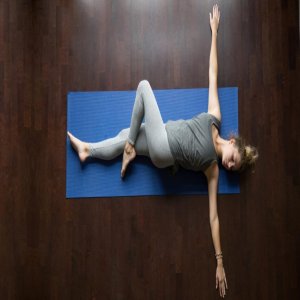
Lie in a supine position; adjust your lower back by sliding your tailbone and hips towards your heels so that your lower back is firmly resting on the ground without any gap or arch.
Interlace your fingers and put them beneath your head.
Exhale and bend your right knee; rotate your lower back to place your bent right knee at the left side so that the right foot comes close to the outside of the left knee; simultaneously move your head to the right side; keep sliding the flexed knee up and closer to your chest.
Try as much as possible to keep both your scapulae and elbows on the ground.
Stay in this posture for 30 seconds with normal breathing.
Ensure that your throat muscles are relaxed.
Release and turn to the opposite side by changing your head and leg position.
Pause for an equal length of time.
Contraindications for One Leg Uttana Vakrasana:
- Avoid doing this posture in case of acute abdominal pain or any kind of spinal problem.
Vishishta Uttan Vakrasana Spinal Twist with legs crossed
How to do Vishishta Uttan Vakrasana Spinal Twist with legs crossed?
Lie in a prone position; adjust your lower back by sliding your tailbone and hips down towards your heels so that your lower back is firmly resting on the ground without any gap or arch; get your heel close to your hips; your arms are resting sideways on the ground.
Place left knee over right knee; both the knees are stacked on each other with the right knee at the bottom and left knee at the top; interlock your fingers and place them at the back of your head.
Turn the flex legs towards the right and simultaneously your head towards the left; pause for half a minute with normal breathing; change the side and do the same action.
Meru Vakrasana
What is Meru Vakrasana?
Meru vakrasana is a basic seated pose that gives a gentle spinal twist and serves as a preparatory pose for more intense twisting poses. The term comes from the Sanskrit Meru, which represents “mountain”; vakra, which refers to “twisted” or “curved”; and asana, which means “pose” or “posture.” In English, it is called a simple spinal twist pose.
To perform meru vakrasana, the yogi sits dandasana with the leg straight, then twists the upper body in one direction, placing the hands on the ground outside the leg and hip. The opposite foot (right foot if the twist is to the left) is put just outside the opposite knee with both knees facing skyward.
Benefits of Meru Vakrasana:
This asana works wonders for acidity, constipation, and gas. Apart from that, Meru Vakrasana comes with several other advantages such as:
- It is very advantageous for diabetic patients. Stimulates the pancreas so that the right amount of insulin begins to be produced.
- The extra fat accumulated on the abdomen and waist gradually starts decreasing.
- Reduces the stiffness of the spine and makes it flexible.
- Reduces back pain.
- Keeps the body active.
How to do Meru Vakrasana?
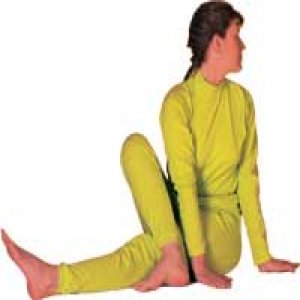
Sit with the legs extended. The torso of the body is upright and relaxed.
Place the hands around 10 cm behind the body with the fingers pointing outwards.
Inhaling bring the right arm to the left side and place the palm or the fingertips beside the left buttock on the ground.
Exhaling bend the right leg and place the foot on the outside of the left thigh on the ground. The body should be erect.
The right buttock should remain in contact with the ground.
Turn the upper body and head to the left, looking back over the left shoulder.
Holding your breath stay in this position for as long as comfortable.
Inhaling returns to the beginning position.
Repeat the exercise to the opposite side.
Precautions to take while doing Meru Vakrasana:
There are certain precautions that one needs to take while performing the Meru Vakrasana since it includes the spine and other major body parts which may have a sprain.
- If you have knee pain, do not perform this asana.
- People who have a severe back problem should not do it.
- If a person is facing an issue of ulcers or any such disease, then they should also avoid performing this asana.
Contraindications for Spinal Twist Pose(Meru Vakrasana):
- Injury and Surgery: Students with injuries at the ankle, wrists, knee, or shoulders should avoid this pose. Students who have undergone recent shoulders, wrists, hip, knee, ankle, or spine surgery need to avoid this twist.
Gatyatmak Meru Vakrasana(Dynamic Spinal Twist)
What is Gatyatmak Meru Vakrasana?
Gatyatmak Meru Vakrasana gets its name from Sanskrit where “Gatyatmak” refers to “Faster” or “Quick”, “Meru” represents “Spinal”, “Vakra” means “Twist” and “Asana” means “Pose” or “Posture”.
The English name of Gatyatmak Meru Vakrasana is The Dynamic Spinal Twist Pose. In the end, pose the body is being twisted quickly and hence the name Gatyatmak Meru Vakrasana.
Benefits of Gatyatmak Meru Vakrasana :
- Gatyatmak Meru Vakrasana or The Dynamic Spinal Twist is beneficial in toning the digestive system and aids in relieving constipation with regular practice.
- This yoga pose also enhances the functioning of the reproductive system.
- Gatyatmak Meru Vakrasana strengthens the supporting tissues and muscles, resulting in more efficient, balanced structural alignment and improving posture.
- It also enhances the physiological functioning of the human body.
- The Dynamic Spinal Twist is also beneficial in increasing blood circulation throughout the abdominal area.
- This yoga pose is also a relaxation position that eases you and makes you feel refreshed if done after a very tiring day at work.
- When practiced daily, it helps in reducing stress and energises the whole body.
- Gatyatmak Meru Vakrasana or The Dynamic Spinal Twist calms the nerves, reduced stress, and aids in getting rid of mild depression.
- It massages the abdominal organs and activates the digestive system thereby improving digestion.
- The Dynamic Spinal Twist strengthens and stretches the hips, lower back, and spine.
- daily practice of this asana makes the spine flexible.
- Gatyatmak Meru Vakrasana is said to hydrate the vertebral discs and open the rib cage to enhance deeper breathing.
- It improves the body’s metabolism and aids in releasing toxins from the body.
- Gatyatmak Meru Vakrasana or The Dynamic Spinal Twist is also advantageous for people suffering from frequent migraine and headaches.
Preparatory Poses for Gatyatmak Meru Vakrasana:
- Twists are Dandasana or The Staff Pose
- Matsyasana (with the legs stretched out) or The Fish Pose
- Rajju Karshanasana or Pulling the Rope Pose
- Chakki Chalanasana or Churning the mill pose
- Ushtrasana or The Camel pose and Bhujangasana or The Cobra Pose
How to Do Gatyatmak Meru Vakrasana or the Dynamic Spinal Twist?
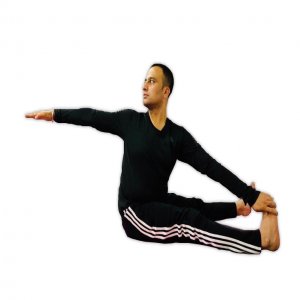
Sit on the ground with both legs outstretched on the ground or the yoga mat.
Spread the legs as far apart.
Make sure that you do not allow the knees to flex while getting into The Dynamic Spinal Twist Pose.
Extend the arms sideways at shoulder level.
While keeping the arms extended, twist to the right and bring the left hand down towards the right big toe to practice the pose.
Stretch the straight right arm behind the back as the trunk twists to the right while doing Gatyatmak Meru Vakrasana.
Make sure that you keep both arms in one straight line while performing The Dynamic Spinal Twist Pose.
While doing the pose turn the head to the right and gaze at the right outstretched hand.
Twist in the opposite direction and bring the right hand down towards the left big toe while practicing the pose.
Stretch the straight left arm behind the back while doing the pose.
Now, while performing Gatyatmak Meru Vakrasana or The Dynamic Spinal Twist Pose, turn the head to the left and gaze at the left outstretched hand.
This completes one round of this asana.
Perform 10 to 20 rounds of The Dynamic Spinal Twist Pose.
You must essentially begin slowly and then gradually increase the speed while doing this yoga pose.
Beginners should try to hold in this position for 1-2 minutes or until your legs and feet start feeling discomfort.
Advanced practitioners should hold in this pose for 3-4 minutes or for as long as they can.
After the asana, rest your body in Shavasana for 1-2 minutes.
Follow Up Poses for Gatyatmak Meru Vakrasana:
- Uttanasana or The Standing Forward Bend Pose
- Nauka Sanchalanasana or Rowing the Boat Pose
- Anulom Vilom or The Alternate Nostril Breathing
- Kapalbhati Pranayama
- Vajrasana or The Diamond pose
Breathing Pattern to Be Followed While doing Gatyatmak Meru Vakrasana or the Dynamic Spinal Twist:
- Breathe in deeply while taking your legs away from each other while getting in Gatyatmak Meru Vakrasana or The Dynamic Spinal Twist. Breathe normally in this pose.
- Inhale deeply again while twisting once while keeping your spine straight.
- Exhale deeply while bringing your body back to the starting position while doing The Dynamic Spinal Twist.
- Keep a constant breath while you are in Gatyatmak Meru Vakrasana keep inhaling and exhaling deeply while staying in the pose.
- Exhale deeply once or twice after letting go of the pose.
Beginner’s tip for Gatyatmak Meru Vakrasana:
Like other Asanas, it is essential that your stomach is empty and your bowels are clean when you perform Gatyatmak Meru Vakrasana or The Dynamic Spinal Twist remember to keep a gap of at least four to six hours between your yoga asanas practice and meal because this will give you proper time to digest the food and create enough vitality and energy for your practice.
You should perform yoga asanas in the morning. In case you cannot do yoga in the morning, you can perform the same in the evening as well.
Variations of Gatyatmak Meru Vakrasana or the Dynamic Spinal Twist:
Variation 1: To make your lower back and sacrum safe, you can modify Gatyatmak Meru Vakrasana or The Dynamic Spinal Twist by placing a blanket or Yoga Block between your knees. Make sure that you place the block between your knees before taking a twist and squeeze the block while twisting to the side from your upper leg. This permits deeper rotation of the lower back. Like in the normal pose, remember to draw your belly away from the knees while performing this variation of Gatyatmak Meru Vakrasana or The Dynamic Spinal Twist.
Variation 2: You can perform another variation of Gatyatmak Meru Vakrasana or The Dynamic Spinal Twist to deepen your breathing. Take a strap and tie it around your shins and upper back. Always keep the buckle of your belt close to the knees so you can tighten and loosen the strap after twisting the knee. This pose brings your knees very near to your belly and promotes deeper breathing.
Variation 3: This variation is for advanced practitioners. While twisting to the opposite side, instead of touching the leg on the ground, you can keep your lower leg one or two inches above the floor in the air.
You can also place a blanket under your pelvis to strengthen the lower spine and support your pelvis.
Precautions and Contraindications While Practicing Gatyatmak Meru Vakrasana or the Dynamic Spinal Twist:
- While doing Gatyatmak Meru Vakrasana or The Dynamic Spinal Twist, make sure that you do not let your knees transfer below your pelvis. This will give a strain on the lumbar vertebrae.
- Make sure that your arms and shoulder blades are touching the floor all the time while performing this yoga pose. If your arms and shoulder blades are raised, this will put a strain on the upper back, shoulders, and neck.
- People suffering from any injury in the hips, knees, and back should not perform a dynamic spinal twist yoga pose.
- People who have had any surgery on the knees, spine, hips, or back currently should also not perform Gatyatmak Meru Vakrasana until they are fully healed.
- People having Hiatal Hernia are not supposed to do this yoga pose.
- People with a very weak sacroiliac Joint are also not supposed to perform this pose.
- Gatyatmak Meru Vakrasana should not be done by people suffering from GERD or Gastro Esophageal Reflux Disease.
- Get out of the pose or release the pose if you experience a sudden sharp and shooting pain in your legs or abdomen.
- If you have any confusion about your condition, consult a physician before doing Gatyatmak Meru Vakrasana or The Dynamic Spinal Twist, and always do asana under the supervision of a trained yoga expert.
- Do not over-exert yourself while doing this asana. Do not push yourself beyond the limits. Go only as much as your body allows.
What is the Contraindication of Vakrasana?
It is recommended not to practice Vakrasana if you are suffering from the following problems:
- Peptic Ulcers
- Spinal Cord Injury
- Hyperthyroidism
- Extreme back pain
- Hernia
- Avoid the practice during sciatica or slipped disc problems.
- Women should not perform Vakrasana after the first trimester of pregnancy.
- Do not try to perform Vakrasana in cases of abdominal surgery.
- Do not try to perform Vakrasana if suffering from knee pain.
- Do not try to perform Vakrasana if you have an underlying heart or brain condition.
- Practice the pose under supervision in case of a stiff spine.
What are the DO and DON’TS for Vakrasana?
DO’S:
- Keep the left leg straight. Turn to the left side of the spine, turn the shoulders, and head to the left.
- Try to keep both the buttocks firmly on the floor.
- Try to keep the right foot close to the body.
- Place both the palms on the floor close to the left thigh with fingertips facing each other.
- Only twist as far as you can keep your neck and back straight.
DON’TS:
- Raise either of the buttocks off the floor.
- Let the flexed leg fall away.
- Let the back or neck flex.
- Over strain the knees.
Bottom Line
Vakrasana or Simple Spinal Twist or Twisted Pose is a simple yet effective yoga position that provides a range of health advantages. It activates the pancreas, facilitates digestion, reduces belly fat, and reduces the stiffness of the spine. Additionally, it stretches the legs and hip joints. Practicing this pose daily can aid improve spinal health, and digestion, and relieve backache. So go on and give it a try.

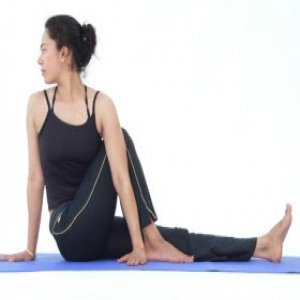
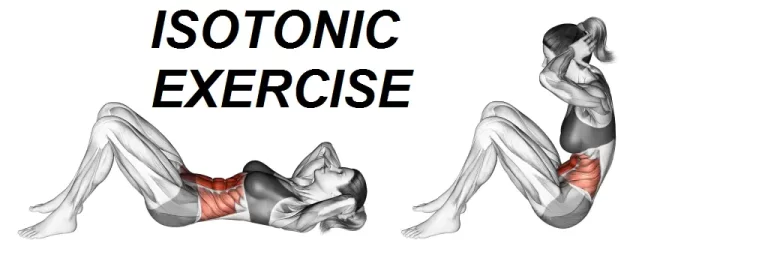

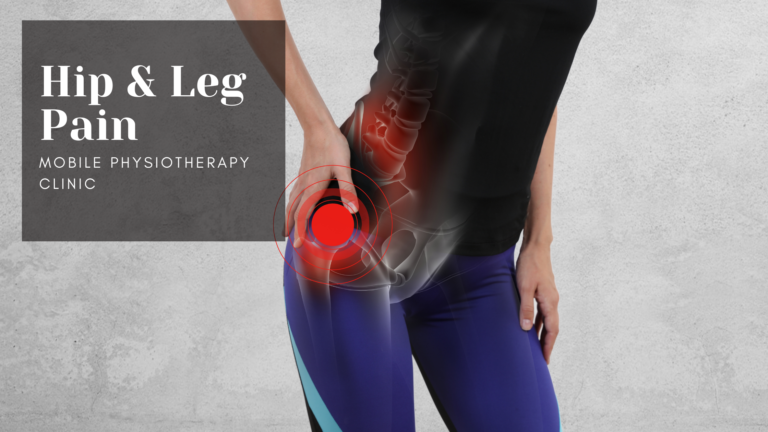

One Comment